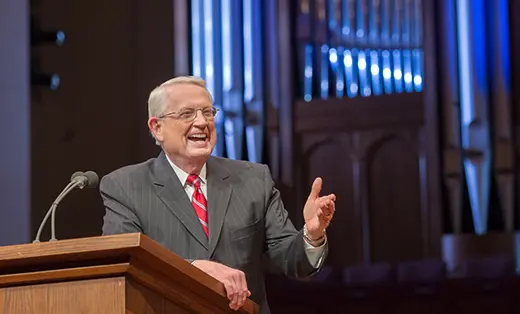Marriage Is God’s Invention
By Pastor Chuck Swindoll
Chapter 2 of Genesis is a story. If we are careful to examine the symbols and how the inspired author writes the story, we’ll discover that marriage is God’s invention. He intended this lifelong, exclusive union between a man and a woman to become the foundation upon which a family is built. This first of all human relationships goes all the way back to creation.
God placed the solitary human male in a garden that would supply his every physical need, yet His evaluation was, in effect, “He still has a need.” So the Creator said, “I will make him a helper suitable for him.” Notice two words in particular: “helper” and “suitable.”
Adam needed a helper. Now I can almost hear the gasps, but before we read too much English into the word helper, we need a little help from Hebrew grammar. “Helper” sounds menial, even a little pathetic. We think of one person having the knowledge and skill to accomplish a task while the “helper” merely makes the job easier. But that’s not how the Hebrews used it. The word ezer has the idea of supplying something crucial that is lacking, and it most often refers to God (Psalm 30:10, 54:4).
“Helper” in the Hebrew mind is anything but menial. God saw Adam and determined that something crucial was missing. Humankind was incomplete. His aloneness was not good. We know from Genesis 1 that humans were to multiply, fill the earth, and rule over it. Adam was made for a purpose that he could not fulfill alone. The song of life was to be sung as a duet, in harmony, but Adam was only one voice. His solo wouldn’t cut it.
Furthermore, only the right kind of voice would suffice. Notice that the helper must be a “suitable” helper or, more literally, “one according to his opposite” or “one corresponding to him.” This second human creation would have to be a very different being than any that had been created.
So God created the woman from Adam’s rib (Genesis 2:21–23). Once Adam “recovered from surgery” he opened his eyes and saw the woman. The Hebrew is emphatic so that his first words should be translated, “Now, finally, at last!” She perfectly complemented his every strength and weakness the way no other creature could. Adam’s declaration, “This is now bone of my bones, and flesh of my flesh,” is the basis for a Hebrew expression describing closeness, oneness, or intimacy. It communicates that she is the fulfillment of everything he desired. And having seen every other creature God had made, he was in a good position to know. This is a magnificent scene played out in an idyllic setting, and it’s the beginning of a wonderful love story.
Adam and Eve before the fall are our models. Pure, uninhibited, unselfish, blissful union enjoyed by two people made for each other. No barriers. No issues. No awkwardness. No hang-ups. Just intimacy.
Adapted from Charles R. Swindoll, Marriage: From Surviving to Thriving (Nashville: W Publishing Group, 2006), 29–35. Copyright © 2006 by Charles R. Swindoll, Inc. All rights reserved worldwide.
About the author
 Pastor Chuck Swindoll
Pastor Chuck Swindoll
Pastor Charles R. Swindoll has devoted his life to the accurate, practical teaching and application of God’s Word. He is the founding pastor of Stonebriar Community Church in Frisco, Texas, but Chuck’s listening audience extends far beyond a local church body. As a leading program in Christian broadcasting since 1979, Insight for Living airs around the world. Chuck’s leadership as president and now chancellor emeritus at Dallas Theological Seminary has helped prepare and equip a new generation of men and women for ministry.
